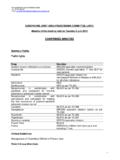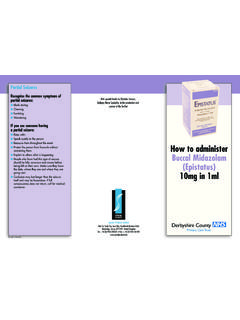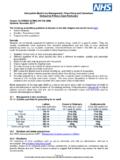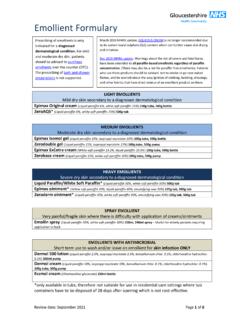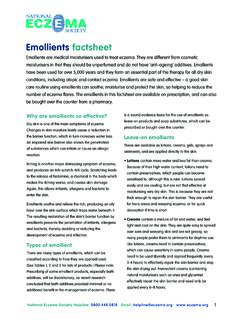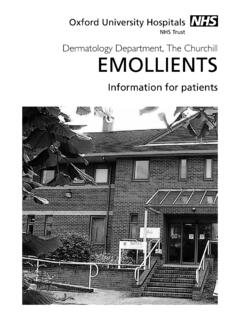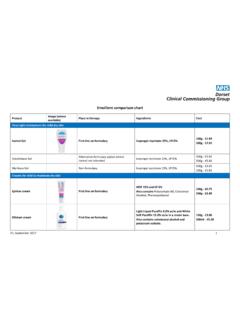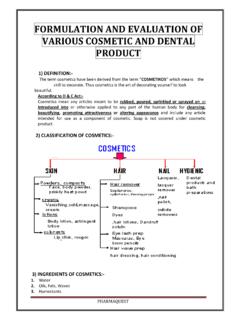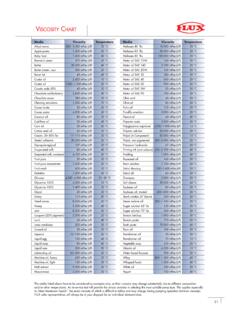Transcription of Derbyshire Medicines Management, Prescribing and ...
1 Reviewed: November 2019 Next Review Date: October 2022 Prices from Drug Tariff November 19 Derbyshire Medicines Management, Prescribing and Guidelines Derbyshire Primary Care Formulary Emollient Prescribing Guide (Promote self-care when a moisturiser is required for simple dry skin) Mild Dry Skin (Lotions/creams) Moderate Dry Skin (Creams/ointments/gels) Severe Dry Skin (Ointments) High paraffin content Epimax Original Creamss 500g Easy Squeeze dispenser white soft paraffin 15%, liquid paraffin 6% ExmaQS 500g tub white soft paraffin 15%, liquid paraffin 6% Epimax Oatmeal cream 500g Easy Squeeze dispenser Polyoxyethylene hydrogenated castor oil 38%, LP, WSP Aquamax cream 500g tub white soft paraffin 20%, liquid paraffin 8%.
2 ExoCream 500g pump dispenser white soft paraffin , light liquid paraffin , hypoallergenic anhydrous lanolin 1% ZeroCream 500g pump dispenser liquid paraffin , white soft paraffin AproDerm Emollient Cream LP 500g pump dispenser liquid paraffin 6% Epimax Isomol Gel LP 500g Easy Squeeze dispenser Isopropyl myristate 15%, liquid paraffin 15% Epimax ExCetra cream 500g Easy Squeeze dispenser white soft paraffin , light liquid paraffin Zerobase Cream 500g pump dispenser white soft paraffin 10%, liquid paraffin 11% Oilatum Cream 500ml pump dispenser 1050ml pump dispenser Light liquid paraffin 6%, white soft paraffin 15% Imuderm Creamss LP (contains urea 5%)
3 500g pump dispenser Epimax ointment ss 500g tub Yellow soft paraffin 30%, liquid paraffin 40%, emulsifying wax 30% AproDerm Ointment 500g tub white soft paraffin 95%, liquid paraffin 5% Zeroderm ointmentss 500g tub white soft paraffin 30%, liquid paraffin 40%, emulsifying wax 30% Ovelle Emulsifying ointment 500g tub white soft paraffin 50%, liquid paraffin 20%, Emulsifying wax 30%, white soft paraffin 50% / liquid paraffin 50% ointment 500g tub WSP 50%, LP 50% If antibacterial function required: Dermol Cream/ Lotionss LP 500ml pump dispenser paraffin free option: Epimax paraffin -free ointment 500g tub , AproDerm Colloidal Oat Cream 500g pump dispenser This is a guide only.
4 Additional factors should be considered before Prescribing any emollient - see overleaf. All of the above preparations can be used as a soap substitute. Those designated with ss have specifically been listed in MIMs for use as soap substitute. Products contain a variety of excipients check before Prescribing if patients have known sensitivities. Those designated with LP have low paraffin content of 20%. There is a fire risk with all paraffin -containing emollients, regardless of paraffin concentration, and it also cannot be excluded with paraffin -free emollients.
5 A similar risk may apply for other products which are applied to the skin over large body areas or in large volumes for repeated use for more than a few days. See MHRA -advise patients who use these products not to smoke or go near naked flames, and warn about the easy ignition of clothing, bedding, dressings, and other fabric that have dried residue of an emollient product on them. Reviewed: November 2019 Next Review Date: October 2022 Prices from Drug Tariff November 19 Guidance notes for choosing the correct emollient for your patient Emollient choice for dry skin Generally the greasier an emollient is the more effective it is.
6 All should be applied frequently at least twice per day. Lotions Needs reapplying frequently on very dry skin Good for very mild dry skin and also for the face Creams Less greasy but more effective than mild emollients More cosmetically acceptable than oil based moisturisers Ointments Generally greasy Tolerated less well with older children / adults Ideal under wet wraps Patients who report stinging with emollients - consider an alternative product. See MIMs for a full list of emollients and potential skin sensitisers In patients with frequent infections consider the Dermol range For patients with problems applying cream consider Emolin spray.
7 How s and whys of emollient use Create a personalised emollient programme. Instruct on correct emollient application in direction of hair growth and : Gently Quickly Frequently Stress regular emollient is the key to settling dry skin conditions. There are no standard rules regarding whether to apply a topical steroid preparation after or before using an emollient. Some people are happiest using an emollient first to prepare the skin, followed by the steroid. However, whichever order of care you choose it is important that you leave at least hr between the two treatments to avoid diluting the strength of the topical steroid preparation, and to prevent the spread of topical steroids and calcineurin inhibitors to areas not affected by eczema (NES).
8 Awareness of health issues, NPSA awareness on fire risk, folliculitis (apply in direction of hair growth to reduce risk of folliculitis), allergies, contamination (emollient preparations contained in tubs should be removed with a clean spoon or spatula to reduce bacterial contamination of the emollient) and emollients and slippery surfaces. Baths/Shower Emollients Do Not Prescribe (DNP) Avoid bubble baths and soaps Use a leave on emollient as a soap substitute Epi-max, ExmaQS. Encourage to bathe regularly. JAPC has classified all bath and shower emollients as DNP.
9 Functions of the bath routine are to: Clean the skin preventing infection by removing scales, crusts, dried blood and dirt from the skin. Moisturises the skin and reduce discomfort caused by dry skin Hydrates the skin making it more receptive to active topical therapy, topical corticosteroids. Consider when Prescribing emollients Patient lifestyle and preference - may prefer light moisturiser during day and greasy one at night. Previous emollients - may have tried other moisturisers with little benefit. Cost - moisturisers vary greatly in NHS and/or OTC price.
10 Prescribing amounts - refer to BNF chapter 13 (suitable quantities for Prescribing ). Prescribe sufficient quantities once patient has settled on an emollient - may require 500g or more per month. Document Update Date updated Epimax range name change- Epimax cream, ExCetra cream and Isomol gel Nov 2020 Black TLC updated to DNP TLC Jan 2021 Exmabase removed due to discontinuation March 2022

